The Console Is King: UM Project and Allen Farmelo Re-Imagine The Classic Console For A Modern Room
FORT GREENE, Brooklyn: “It’s like the future of yesterday, today!” A step into Allen Farmelo‘s Fort Greene mix room reveals a unique new console which sports sleek, retro-futurist lines, and suggests an untapped ability to serve double-duty as the helm for the Star Trek Enterprise.
Housing up to 24 channels of API channel strips, an integrated control surface, a computer keyboard, and speaker stand, this striking new desk-on-wheels owes much of its heritage to classic “mid-century modern” designs, where form and function are effortlessly linked together by a minimalist’s eye.
Although it looks like a factory-fresh commercial console, the new board is actually an ingeniously designed housing that could be filled with any variety of 19-inch rack gear.
For his custom desk, Farmelo took the idea one step further by working exclusively with API’s Legacy-series channel strips, which bring the full functionality of an analog console to bear, providing classic EQ and dynamic control as well as built-in auxiliary and multi-bus routing.
This promising new concept is the moss-green fruit of a collaboration between Farmelo and a French-born Brooklyn designer named Francois Chambard, who runs his own boutique design outfit, UM Project.
Despite it’s high-dollar look, feel, and performance, Farmelo says that everyday studio owners would be surprised by just how much they can accomplish with Chambard, a craftsman he calls “an incredible resource for the recording community.”
While it didn’t make financial sense for Farmelo to buy a 16-channel API or Portico system at $50,000 off-the-shelf, he says he could get started on building a great-sounding modular console bit-by-bit as his needs evolved.
Farmelo’s genuine satisfaction with Chambard’s work is clear: ”Just look at it,” he says. “It’s indestructible, collapsible, and uniquely beautiful. He can design you a desk from scratch, and build it himself. And the whole thing is customizable. You could do the same kind of thing with your favorite 500-series modules and a Dangerous summing box. Whatever you want.”
Since the analog routing built into the Legacy series strips is a rare luxury among 19-inch rack gear, engineers looking to follow in Farmelo’s footsteps might simply rely on their DAW for grouping and sending, design an analog routing matrix for 19-inch rack pieces, or commission Chambard to build a frame for their favorite vintage console strips and master section.
A Unified Workflow & Sonic Palette
More than just providing a unique and breathtaking retro-modern look to fill out the room, the new console is evidence of one man’s desire to address the functional shortcomings he sees in today’s DAW-centric studios. “It seems everyone has got ten different preamps, 30 different mics, and a thousand different plug-ins,” says Farmelo. “When it comes to the mix, people spend half their time just trying to get it to all sit together. It’s like a picture that’s been painted with oils, acrylics, charcoals, and pastels all a once. That approach can make it very hard to get a cohesive sound.”
Frustrated with the work-flow of these piecemeal-style studios, Farmelo started cleaning house in his own racks: “When I finally heard the API 7600 channel strip, I said to myself: ‘Good. Done!’ It’s got one of the best preamps in the world, one of the best EQs in the world, and a really great compressor for controlling dynamics.”
Once he amassed a respectable handful of these channel strips to serve as a recording and summing system for his personal mix room, Farmelo never looked back:
“My goals is to unify my work-flow and my sounds by limiting the choices I have. I’m tired of all the options, tired of finding out how awesome the next thing is. I want to make records, not shop for the next must-have compressor! I believe that one of my jobs is to create a convincing ‘other reality’ in my work. This approach helps me achieve a cohesive tonal unity in my mixes. That’s what’s missing in the digital realm.”
Even with fewer than a dozen API strips filling his bays, Farmelo heard what he was hoping for. But creating a unified sonic palette wasn’t the only goal. When he realized he was essentially building a console in his racks, Farmelo figured he could take it one step further: by removing the strips from traditional horizontal racks, where they lay on their sides, far and away from the sweet spot.
Working with Chambard to build a console-style housing complete with faders was the next logical step, and, it helped him fill in the last piece of the work-flow puzzle: “Working with a console allows you to turn off the screen and use your whole brain on the mix. You’d be amazed by how much using a mouse and staring at a waveform takes away from listening.”
A New Golden Age: The Console Comes Full Circle
In many ways, the idea that recording consoles are great for recording studios is nothing new; maybe “no-brainer” to boot. The idea of developing a personalized small-format console, built to the demands of an individual studio ties us back to the very roots of the recording craft. Step by step-by-step, engineers at RCA, Neumann, and Universal invented and expanded upon the first multichannel audio desks. And now the console has come full-circle once again.
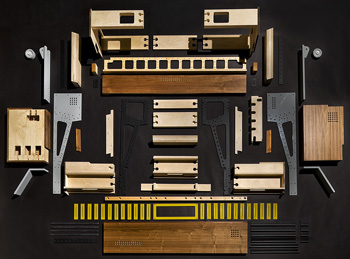
Modular Design: A view of the analog console, pre-assembly. Puzzle pieces! Photo by Francis Dzikowski.
Traditional consoles “evolved,” says Farmelo and like-minded colleagues, to suit the specific needs of multi-track recordists. It’s not surprising that many of those needs have yet to change.
What is surprising is just how much Farmelo and Chambard found in common as they compared notes. For visual cues, they initially bonded over mutual appreciation for classic mid 20th century design, Scandinavian minimalist sensibilities, and the landscape and architecture of Iceland. And as for process?
Chambard, a soft spoken and thoughtful craftsman, could also identify with the analog/digital duality of the recording world: “My process is analog, but I embrace the digital world as well. I like to think of it as “techno-craft.” Borrowing back and forth between the contemporary computer-assisted world of industrial design, and the tradition of craft and handmade goods.”
Farmelo elaborates: “Francois has the challenge bringing industrial steel and wood together, and I have the challenge of bringing a software arpeggio and a string quartet together. We have to both highlight those differences and blend them together in a way that works.”
He also raves over Chambard’s handling of the small decisions that make a big purchase difficult.
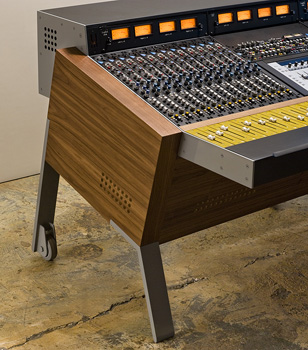
Yes, this desk is on wheels – simply lift from the front and wheel into place. Photo by Francis Dzikowski.
“The console design took 2 minutes to sign off on. I immediately said ‘This is beautiful, let’s do it’! But then I obsessed over the color, a non-essential, in the same way one of my mix clients might obsess over a reverb tail or a non-essential keyboard part. When I was obsessing over the color, Francois handled it hopefully the way I handle it with my clients; He was firm about what he thought would work, but he was also very positive and receptive.”
And the result? Farmelo got what he wanted: “A console that combines the size and functionality of an SSL AWS 900, the vibe of a Quad Eight, but loaded with API gear? If someone described that to me, I’d say “perfect!”
When questioned about why he’d build an analog console in a digital age, where plug-in manufacturers are already addressing the missing “sonic gel” like-minded engineers have been complaining about, he has this to say:
“The further we go with digital, the more obsessed we get with analog. Look around! We’re in the second golden age of analog equipment. Look at how many companies are building retro gear.
“The great irony is that that digital was supposed to bury analog, but it’s made consoles and outboard gear come into massive abundance. It’s even brought vinyl back! I don’t we’ll ever get away from analog completely.”
And if we do?
“If that’s true, and I’m in the last of a dying breed, then okay. If that’s my place in the world, so be it. I’m no Luddite. In the end, I think technology will save us. If my great-grand-nephews make records on digital-liquid-crystal-gear-from-mars, more power to them.”
More than taking a side on the perpetual analog/digital debate, Farmelo has message of self-direction and encourages other engineers to make their own bold choices:
“People shouldn’t be afraid to build their own thing. It’s scary at first, but if every studio is using the same digital emulations, and the code never changes we run the risk of having all our records sound the same.”
In the end, Farmelo knows “this is something I’m going to spend 10 hours a day behind, almost every day of the week, for the rest of my working life. I’m happy about that.”
For more on producer/engineer Allen Farmelo (The Cinematic Orchestra, The Loom) and to get in touch, visit http://www.farmelo.com; and learn more about Francois Chambard’s UM Project via http://www.umproject.com.
Justin Colletti is a Brooklyn-based audio engineer and music producer who’s worked with Hotels, DeLeon, Soundpool, Team Genius and Monocle, as well as clients such as Nintendo, JDub, Blue Note Records, and the Metropolitan Museum of Art. Visit him at http://www.justincolletti.com.







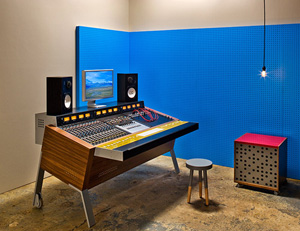
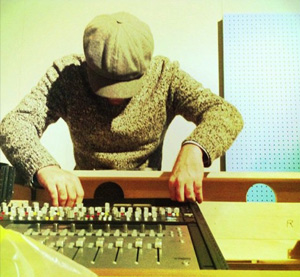
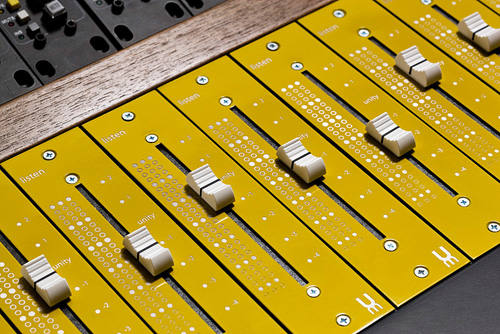
Kaya Bailey
February 24, 2011 at 10:29 pm (14 years ago)That is stunning
Kaya Bailey
February 24, 2011 at 10:30 pm (14 years ago)Absolutely Stunning piece of work